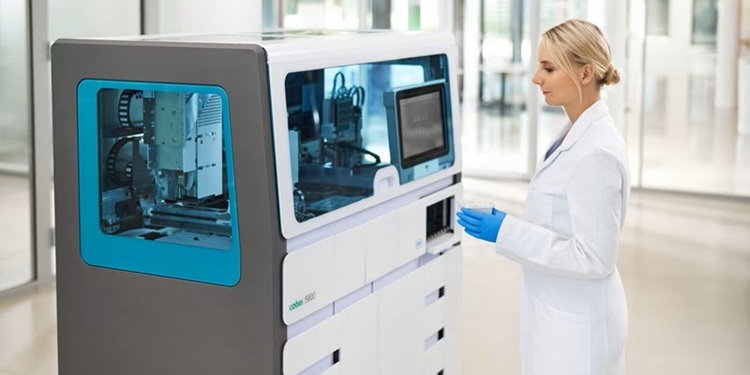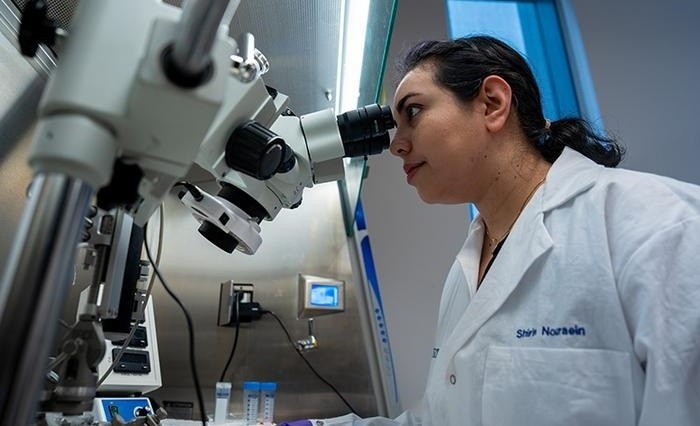Rapid Molecular Diagnosis of Strep A Infections Now Available in Multiple US Healthcare Settings
|
By LabMedica International staff writers Posted on 10 Aug 2015 |
A molecular diagnostic platform that detects Group A Streptococcus (GAS) infections in eight minutes or less was awarded a CLIA (Clinical Laboratory Improvement Amendments) waiver by the [US] Food and Drug Administration, which paves the way for its use in a broad range of healthcare settings.
The Alere Inc. (Waltham, MA, USA) i Strep A test, which was initially approved for diagnostics use in the USA in April 2015, now joins the Alere i Influenza A & B assay as the first-ever molecular tests to receive a CLIA waiver.
Alere i Strep A detects GAS bacteria in throat swab specimens using the company's proprietary Molecular in Minutes (MIM) isothermal nucleic acid amplification technology (iNAT). Unlike polymerase chain reaction (PCR) tests, iNAT does not require lengthy and complex thermocycling or DNA purification and can therefore deliver PCR-caliber results more quickly and in a broad range of settings. Thus rapid (less than eight minutes) GAS diagnostics will be available in a broad range of healthcare settings, including physician offices, hospital emergency rooms, and retail and walk-in clinics in the USA.
“Strep A is highly transmissible, and prompt treatment is critical to reducing the spread of the infection to others. With CLIA waiver for the Alere i Strep A test, we can help link more people to early treatment by bringing rapid molecular diagnosis to even more settings where they seek health care,” said Avi Pelossof, global president of infectious disease at Alere.
Related Links:
Alere Inc.
The Alere Inc. (Waltham, MA, USA) i Strep A test, which was initially approved for diagnostics use in the USA in April 2015, now joins the Alere i Influenza A & B assay as the first-ever molecular tests to receive a CLIA waiver.
Alere i Strep A detects GAS bacteria in throat swab specimens using the company's proprietary Molecular in Minutes (MIM) isothermal nucleic acid amplification technology (iNAT). Unlike polymerase chain reaction (PCR) tests, iNAT does not require lengthy and complex thermocycling or DNA purification and can therefore deliver PCR-caliber results more quickly and in a broad range of settings. Thus rapid (less than eight minutes) GAS diagnostics will be available in a broad range of healthcare settings, including physician offices, hospital emergency rooms, and retail and walk-in clinics in the USA.
“Strep A is highly transmissible, and prompt treatment is critical to reducing the spread of the infection to others. With CLIA waiver for the Alere i Strep A test, we can help link more people to early treatment by bringing rapid molecular diagnosis to even more settings where they seek health care,” said Avi Pelossof, global president of infectious disease at Alere.
Related Links:
Alere Inc.
Read the full article by registering today, it's FREE! 

Register now for FREE to LabMedica.com and get access to news and events that shape the world of Clinical Laboratory Medicine. 
- Free digital version edition of LabMedica International sent by email on regular basis
- Free print version of LabMedica International magazine (available only outside USA and Canada).
- Free and unlimited access to back issues of LabMedica International in digital format
- Free LabMedica International Newsletter sent every week containing the latest news
- Free breaking news sent via email
- Free access to Events Calendar
- Free access to LinkXpress new product services
- REGISTRATION IS FREE AND EASY!
Sign in: Registered website members
Sign in: Registered magazine subscribers
Latest Microbiology News
- Rapid POC Tuberculosis Test Provides Results Within 15 Minutes
- Rapid Assay Identifies Bloodstream Infection Pathogens Directly from Patient Samples
- Blood-Based Molecular Signatures to Enable Rapid EPTB Diagnosis
- 15-Minute Blood Test Diagnoses Life-Threatening Infections in Children
- High-Throughput Enteric Panels Detect Multiple GI Bacterial Infections from Single Stool Swab Sample
- Fast Noninvasive Bedside Test Uses Sugar Fingerprint to Detect Fungal Infections
- Rapid Sepsis Diagnostic Device to Enable Personalized Critical Care for ICU Patients
- Microfluidic Platform Assesses Neutrophil Function in Sepsis Patients
- New Diagnostic Method Confirms Sepsis Infections Earlier
- New Markers Could Predict Risk of Severe Chlamydia Infection
- Portable Spectroscopy Rapidly and Noninvasively Detects Bacterial Species in Vaginal Fluid
- CRISPR-Based Saliva Test Detects Tuberculosis Directly from Sputum
- Urine-Based Assay Diagnoses Common Lung Infection in Immunocompromised People
- Saliva Test Detects Implant-Related Microbial Risks
- New Platform Leverages AI and Quantum Computing to Predict Salmonella Antimicrobial Resistance
- Early Detection of Gut Microbiota Metabolite Linked to Atherosclerosis Could Revolutionize Diagnosis
Channels
Clinical Chemistry
view channel
Chemical Imaging Probe Could Track and Treat Prostate Cancer
Prostate cancer remains a leading cause of illness and death among men, with many patients eventually developing resistance to standard hormone-blocking therapies. These drugs often lose effectiveness... Read more
Mismatch Between Two Common Kidney Function Tests Indicates Serious Health Problems
Creatinine has long been the standard for measuring kidney filtration, while cystatin C — a protein produced by all human cells — has been recommended as a complementary marker because it is influenced... Read moreMolecular Diagnostics
view channel
Four-Gene Blood Test Rules Out Bacterial Lung Infection
Lower respiratory tract infections (LRTIs) are among the most common reasons for antibiotic prescriptions, yet distinguishing bacterial infections from viral ones remains notoriously difficult.... Read more
New PCR Test Improves Diagnostic Accuracy of Bacterial Vaginosis and Candida Vaginitis
Bacterial vaginosis (BV) impacts approximately 25% of women of reproductive age, while up to 75% of women experience candida vaginitis (CV) at least once in their lifetime. Vaginal symptoms are one of... Read moreHematology
view channel
Platelet Activity Blood Test in Middle Age Could Identify Early Alzheimer’s Risk
Early detection of Alzheimer’s disease remains one of the biggest unmet needs in neurology, particularly because the biological changes underlying the disorder begin decades before memory symptoms appear.... Read more
Microvesicles Measurement Could Detect Vascular Injury in Sickle Cell Disease Patients
Assessing disease severity in sickle cell disease (SCD) remains challenging, especially when trying to predict hemolysis, vascular injury, and risk of complications such as vaso-occlusive crises.... Read more
ADLM’s New Coagulation Testing Guidance to Improve Care for Patients on Blood Thinners
Direct oral anticoagulants (DOACs) are one of the most common types of blood thinners. Patients take them to prevent a host of complications that could arise from blood clotting, including stroke, deep... Read moreImmunology
view channel
New Test Distinguishes Vaccine-Induced False Positives from Active HIV Infection
Since HIV was identified in 1983, more than 91 million people have contracted the virus, and over 44 million have died from related causes. Today, nearly 40 million individuals worldwide live with HIV-1,... Read more
Gene Signature Test Predicts Response to Key Breast Cancer Treatment
DK4/6 inhibitors paired with hormone therapy have become a cornerstone treatment for advanced HR+/HER2– breast cancer, slowing tumor growth by blocking key proteins that drive cell division.... Read more
Chip Captures Cancer Cells from Blood to Help Select Right Breast Cancer Treatment
Ductal carcinoma in situ (DCIS) accounts for about a quarter of all breast cancer cases and generally carries a good prognosis. This non-invasive form of the disease may or may not become life-threatening.... Read morePathology
view channelAI Tool Outperforms Doctors in Spotting Blood Cell Abnormalities
Diagnosing blood disorders depends on recognizing subtle abnormalities in cell size, shape, and structure, yet this process is slow, subjective, and requires years of expert training. Even specialists... Read more
AI Tool Rapidly Analyzes Complex Cancer Images for Personalized Treatment
Complex digital biopsy images that typically take an expert pathologist up to 20 minutes to assess can now be analyzed in about one minute using a new artificial intelligence (AI) tool. The technology... Read moreTechnology
view channel
AI Saliva Sensor Enables Early Detection of Head and Neck Cancer
Early detection of head and neck cancer remains difficult because the disease produces few or no symptoms in its earliest stages, and lesions often lie deep within the head or neck, where biopsy or endoscopy... Read more
AI-Powered Biosensor Technology to Enable Breath Test for Lung Cancer Detection
Detecting lung cancer early remains one of the biggest challenges in oncology, largely because current tools are invasive, expensive, or unable to identify the disease in its earliest phases.... Read moreIndustry
view channel
Abbott Acquires Cancer-Screening Company Exact Sciences
Abbott (Abbott Park, IL, USA) has entered into a definitive agreement to acquire Exact Sciences (Madison, WI, USA), enabling it to enter and lead in fast-growing cancer diagnostics segments.... Read more











 Analyzer.jpg)













